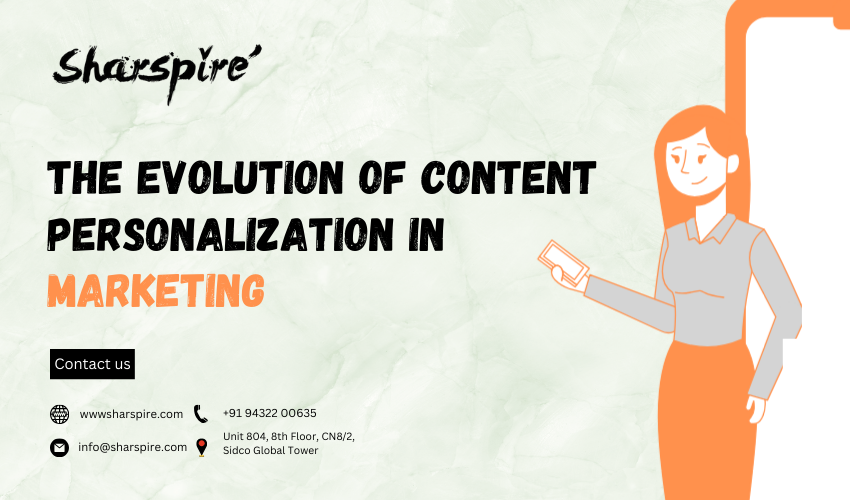Content personalization in marketing has evolved dramatically over the years, driven by advancements in technology, data analytics, and consumer expectations. This journey from broad-based marketing to highly tailored, individualized content reflects a deeper understanding of the customer journey and the power of relevance in driving engagement and conversions.
The Early Days: One-Size-Fits-All Marketing
In the early days of marketing, content was primarily one-size-fits-all. Brands focused on mass communication, delivering the same message to all potential customers. This approach, while effective in building brand awareness, often lacked the ability to resonate with individual consumers. The content was generic, aimed at reaching the largest possible audience with minimal regard for individual preferences or behaviors.
The Rise of Data-Driven Insights
The first significant shift toward content personalization came with the rise of data-driven insights. As businesses began to collect and analyze data on customer behavior, preferences, and demographics, they realized the potential of tailoring content to different segments of their audience. Segmentation allowed marketers to create more relevant messages for specific groups, improving engagement and response rates.
With the advent of the internet and digital marketing, the amount of data available to marketers grew exponentially. Tools like Google Analytics, CRM systems, and social media platforms provided deeper insights into customer behavior, enabling more sophisticated segmentation strategies. Marketers could now deliver content based on factors like age, location, interests, and past purchase behavior, marking the beginning of more personalized marketing efforts.
The Emergence of Automation and AI
The next major leap in content personalization came with the introduction of marketing automation tools and artificial intelligence (AI). These technologies enabled marketers to scale their personalization efforts, automating the delivery of customized content to thousands or even millions of individuals.
AI-powered tools like recommendation engines, predictive analytics, and dynamic content creation began to transform how brands interact with their customers. For example, e-commerce platforms started using AI to recommend products based on a user’s browsing history or previous purchases. Email marketing campaigns could be tailored in real-time, adjusting content based on the recipient’s interactions with previous emails.
Real-Time Personalization and Behavioral Targeting
As technology continued to evolve, so did the capabilities of content personalization. Real-time personalization and behavioral targeting became the new norm, allowing marketers to deliver content that adapts instantly to a user’s actions. Whether a customer is browsing a website, opening an app, or interacting on social media, real-time personalization ensures that the content they see is immediately relevant to their current context.
This level of personalization is made possible by advanced data processing and AI. Marketers can now track and analyze user behavior in real-time, enabling them to deliver highly relevant content at the exact moment a customer is most likely to engage. For example, if a user abandons a shopping cart, they might receive a personalized email with a discount offer just minutes later, encouraging them to complete the purchase.
The Role of Omnichannel Personalization
Another significant evolution in content personalization is the shift towards omnichannel personalization. Consumers now interact with brands across multiple channels, including websites, mobile apps, email, social media, and in-store experiences. To maintain a consistent and personalized experience, marketers must ensure that their content is seamlessly integrated across all these touchpoints.
Omnichannel personalization involves creating a unified view of the customer, where data from all channels is combined to inform content strategies. This approach not only improves the relevance of content but also enhances the overall customer experience, as consumers receive a consistent message regardless of how they interact with the brand.
The Future of Content Personalization
The future of content personalization is likely to be shaped by ongoing advancements in AI, machine learning, and data privacy regulations. As consumers become more aware of how their data is used, there will be a greater emphasis on ethical personalization practices, where brands must balance relevance with respect for privacy.
AI and machine learning will continue to drive innovation, enabling even more precise and predictive personalization strategies. Brands will be able to anticipate customer needs before they arise, delivering content that feels not just personalized, but almost intuitive.
In addition, the rise of immersive technologies like virtual reality (VR) and augmented reality (AR) will open new possibilities for personalized content experiences. Imagine walking into a virtual store where every product recommendation is tailored specifically to your tastes and preferences, or receiving personalized content overlays in an augmented reality environment.
Conclusion
Content personalization has come a long way from its early days of broad segmentation and generic messaging. Today, it’s about delivering the right content, to the right person, at the right time, across all channels. As technology continues to evolve, so too will the ways in which marketers can create personalized experiences that resonate deeply with consumers, driving engagement, loyalty, and ultimately, business success. The future of content personalization is bright, promising even more innovative ways to connect with audiences on a personal level.





